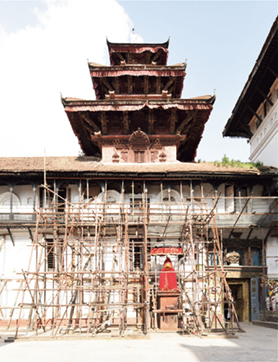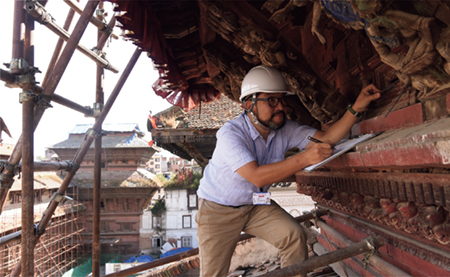Stories from the Field 03
Sharing Japan's Advanced Restoration Techniques with Engineers in Nepal
– Aiming to Restore World Heritage Sites Destroyed by the Earthquake
On April 25, 2015, an earthquake with a magnitude of 7.8 struck Central Nepal, causing extensive damage across a wide area including in the capital of Kathmandu. During the quake, many of the heritage sites in the Kathmandu Valley World Heritage Site, including Durbar Square and multi-tiered towers constructed at temples, collapsed and suffered catastrophic damage. Many properties consisting of the World Heritage Site of Katmandu Valley form the identity of Nepalese life and culture, and they are also important tourism resources. It is the hope of the Nepalese people that the cultural properties will be restored to their original form as quickly as possible. Thus, there was an urgent need to prepare reference materials for the accurate restoration of these cultural properties and secure parts for the collapsed structures.
Japan proactively provided assistance in the immediate aftermath of the quake. This has included not only equipment for restoration, but also technical advice for the Project on rehabilitation and conservation from Nepal Earthquake and enhancement of project management capacities, all in an effort to restore Nepal's World Heritage Sites. During this process, Japan shares its accumulated sophisticated techniques in restoring and seismically retrofitting cultural properties without losing their cultural significance, with local engineers in Nepal, and surveys and plans for the restoration process are being carried out together with engineers in Kathmandu.
Nepal's historical structures at first glance look the same as those in western countries, masonry structures with brick exteriors, but in actuality, wood is used on many occasions as structural materials inside of bricks, making these structures a mix of brickwork and woodwork. Therefore, these structures require extensive repair work every 150 to 200 years due to wood rot and aging. Also, major earthquakes typically strike Nepal at the interval of around every several decades to 100 years. In this regard, Nepal closely resembles Japan with its high humidity climate and frequent earthquakes. This is why restoring Nepal's cultural properties by transferring Japan's techniques in cultural heritage restoration is expected to support the cultural identity of the Nepalese people and greatly contribute to the recovery of the country's tourism industry.

Agamchhen Temple and Hanuman Gate, the front gate of Hanuman Dhoka Palace (Photo: Tadatsugu Tai)
Mr. Tadatsugu Tai, who has been dispatched to the Department of Archaeology (DOA) of the Government of Nepal, is a specialist for Cultural Heritages rehabilitation and conservation of Japanese cultural properties in restoring buildings in Japan, such as designated national treasures, important cultural properties and World Heritage Sites. Mr. Tai is now working with engineers at the DOA on planning future restorations and preparations to carry out a survey that will form the basis of actual restoration work. The survey covers Agamchhen Temple (a three-tiered temple built to enshrine the personal deities of the royal family) built in 1649 and Shiva Temple (a two-tiered temple located on the eastern edge of the compound) built in the 1640s, both located inside Hanuman Dhoka Palace. Restoration work will begin on Agamchhen Temple, because of its high tourism value located at the front of the palace and its status as a core property of the World Heritage Site.

Mr. Tadatsugu Tai during a measurement survey on the roof of Agamchhen Temple (Photo: Tadatsugu Tai)
The survey faced a major challenge unique to Nepal. That is, the country does not have established practices for preparing detailed drawings, recordkeeping photographs or survey reports on historical structures. This means there are not enough records to use as a basis for restoring many buildings that collapsed. This is one of the reasons why, as the first stage of the rehabilitation process, Mr. Tai and his colleagues had to conduct survey work after much preparation. Mr. Tai also notes several other challenges the team faced. For example, typically, senior engineers involved in cultural property structures in Japan must be able to carry out all of the work, from surveys and restoration plan formulation, to construction supervision, photograph taking, drawing preparation, and report compilation. In Nepal, however, these processes are customarily carried out by different people, so even for small surveys; there is each person in charge. Therefore, it became difficult to understand exactly which person these techniques should be transferred to.
In response, Mr. Tai is working on identifying or choosing a person he believes would be most suitable to transfer and learn this technique by reviewing the organizational structure of the DOA. At the same time, Mr. Tai decided to assign the important tasks of measurement surveys and provisional work planning to Nepalese junior staff, despite facing such issues, which he believes has helped to deepen their understanding about the need for work to be highly accurate.
“More than anything, my Nepalese colleagues' attitudes and actions began to change after they saw me, a Japanese expert, getting my hands dirty in the field and doing the actual measurements and taking photographs,” says Mr. Tai. Survey work is slated to begin at the start of 2018 and be completed sometime around September and October of the same year. After that spending several months to create the restoration plan, restoration work is expected to be completed on Agamchhen Temple in about two years' time.
<< Previous Page Next Page >>
Main Text | Statistics and Reference Materials | Stories from the Field | Master Techniques from Japan to the World | ODA Topics
